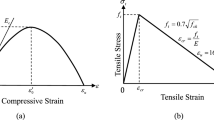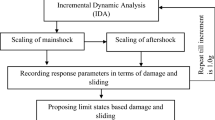Abstract
Rammed earth structures are worldwide spread, both as architectural heritage and new constructions. Yet, rammed earth buildings present, in general, high seismic vulnerability. Despite the several studies conducted on the mechanical characterisation of rammed earth and on the numerical modelling of structural elements built with this material, further in-plane cyclic tests on rammed earth sub-assemblies are required to characterise their hysteretic behaviour. In this framework, an experimental program was conducted where cyclic in-plane tests were performed on a large-scale rammed earth wall. The geometry of the wall was defined to represent a sub-assembly commonly found in rammed earth dwellings from Alentejo (Southern Portugal). The wall was subjected to cyclic shear displacements with increasing amplitude, imposed in both positive and negative directions. To detect the dynamic properties of the wall and to assess the development of the structural damage, dynamic identification tests were conducted along the experimental programme. The results are analysed in terms of crack pattern, dynamic properties, displacement capacity, base shear performance and stiffness degradation. Further discussion is led on the dissipated energy, while a bi-linear and linear equivalent systems are proposed as simplified modelling approach. In conclusion, degradation of structural capacity was observed due to cyclic loads, while adequate energy dissipation and base shear coefficient were obtained.












Similar content being viewed by others
References
Jaquin PA, Augarde CE, Gerrard CM (2008) Chronological description of the spatial development of rammed earth techniques. Int J Arch Herit 2:377–400. https://doi.org/10.1080/15583050801958826
Pacheco-Torgal F, Jalali S (2012) Earth construction: lessons from the past for future eco-efficient construction. Constr Build Mater 29:512–519. https://doi.org/10.1016/j.conbuildmat.2011.10.054
Ciancio D, Jaquin P, Walker P (2013) Advances on the assessment of soil suitability for rammed earth. Constr Build Mater 42:40–47. https://doi.org/10.1016/j.conbuildmat.2012.12.049
Morel JC, Mesbah A, Oggero M, Walker P (2001) Building houses with local materials: means to drastically reduce the environmental impact of construction. Build Environ 36:1119–1126. https://doi.org/10.1016/S0360-1323(00)00054-8
Correia M, Varum H, and Lourenço PB (2015) Common damages and recommendations for the seismic retrofitting of vernacular dwellings. In: M. R. Correia, P. B. Lourenço, and H. Varum (Eds.), Seismic Retrofitting: Learning from Vernacular Architecture. Taylor & Francis Group, London
Lacoutre LEY, Bernal PC, Ortiz JCR, Valencia DR (2007) Estudios de vulnerabilidad sísmica, rehabilitación y refuerzo de casas en adobe y tapia pisada. Apuntes: Revista de Estudios Sobre Patrimonio Cultural 20:286–303
Lourenço PB, Torrealva D, Cancino C, Wong K, Karanikoloudis G, and Ciocci MP (2017) Innovative traditional technologies for rehabilitation and protection of earthen structures: the Getty conservation institute seismic retrofitting project. Proceeding of the 3rd International Conference on Protection of Historical Constructions, Lisbon, 12th - 15th July, 12 - 15.
Bui TT, Bui QB, Limam A, Maximilien S (2014) Failure of rammed earth walls: From observations to quantifications. Constr Build Mater 51:295–302. https://doi.org/10.1016/j.conbuildmat.2013.10.053
Liu K, Wang M, Wang Y (2015) Seismic retrofitting of rural rammed earth buildings using eternally bonded fibers. Constr Build Mater 100:91–101. https://doi.org/10.1016/j.conbuildmat.2015.09.048
Romanazzi A, Oliveira DV, Silva RA (2019) Experimental investigation on the bond behavior of a compatible TRM-based solution for rammed earth heritage. Int J Arch Herit. https://doi.org/10.1080/15583058.2019.1619881
Romanazzi A, Van Gorp M, Oliveira DV, Silva RA, Verstrynge E (2019) Experimental shear behaviour of rammed earth strengthened with a TRM-based compatible technique. Key Eng Mater 817:544–551. https://doi.org/10.4028/www.scientific.net/KEM.817.544
El-Nabouch R, Bui QB, Plé O, Perrotin P (2017) Assessing the in-plane seismic performance of rammed earth walls by using horizontal loading tests. Eng Struct 145:153–161. https://doi.org/10.1016/j.engstruct.2017.05.027
Maniatidis V, Walker P (2008) Structural capacity of rammed earth in compression. J Mater Civ Eng 20:230–238. https://doi.org/10.1061/(ASCE)0899-1561(2008)20:3(230)
Miccoli L, Oliveira DV, Silva R, Müller U, Schueremans L (2015) Static behaviour of rammed earth: experimental testing and finite element modelling. Mater Struct 48:3443–3456. https://doi.org/10.1617/s11527-014-0411-7
Silva RA, Oliveira DV, Miccoli L, and Schueremans L (2014) Modelling of rammed earth under shear loading. Proceeding of the 9th International Conference on Structural Analysis of Historical Constructions, Mexico City, 14th - 17th October.
Bui QB, Bui TT, Tran MP, Bui TL, Le HA (2019) Assessing the seismic behavior of rammed earth walls with an L-form cross-section. Sustainability 11:1296. https://doi.org/10.3390/su11051296
Bui QB, Limam A, Bui TT (2018) Dynamic discrete element modelling for seismic assessment of rammed earth walls. Eng Struct 175:690–699. https://doi.org/10.1016/j.engstruct.2018.08.084
Bui QB, and Bui TT (2020) Seismic behaviour of rammed earth walls: a time history analysis. In: Ha-Minh C., Dao D., Benboudjema F., Derrible S., Huynh D., Tang A. (eds) CIGOS 2019, Innovation for Sustainable Infrastructure. Lecture Notes in Civil Engineering, vol 54.
Bui TT, Bui QB, Limam A, Morel J-C (2016) Modeling rammed earth wall using discrete element method. Continuum Mech Thermodyn 28:523–538. https://doi.org/10.1007/s00161-015-0460-3
Barros RS, Costa A, Varum H, Rodrigues H, Lourenço PB, and Vasconcelos G. (2015) Seismic behaviour analysis and retrofitting of a row building. In Seismic Retrofitting: Learning from Vernacular Architecture.
Allahvirdizadeh R, Oliveira DV, Silva RA (2019) Numerical modeling of the seismic out-of-plane response of a plain and TRM-strengthened rammed earth subassembly. Eng Struct 193:43–56. https://doi.org/10.1016/j.engstruct.2019.05.022
Allahvirdizadeh R, Oliveira DV, Silva RA (2021) Numerical investigation of the in-plane seismic performance of unstrengthened and TRM-strengthened rammed earth walls. Int J Arch Herit. 15:548–566. https://doi.org/10.1080/15583058.2019.1629507
Miccoli L, Drougkas A, Müller U (2016) In-plane behaviour of rammed earth under cyclic loading: Experimental testing and finite element modelling. Eng Struct 125:144–152. https://doi.org/10.1016/j.engstruct.2016.07.010
Tomaževič M, Lutman M (1996) Seismic behavior of masonry walls: modeling of hysteretic rules. J Struct Eng 122:1048–1054. https://doi.org/10.1061/(ASCE)0733-9445(1996)122:9(1048)
Reyes JC, Smith-Pardo JP, Yamin LE, Galvis FA, Sandoval JD, Gonzalez CD, Correal JF (2019) In-plane seismic behavior of full-scale earthen walls with openings retrofitted with timber elements and vertical tensors. Bull Earthq Eng 17:4193–4215. https://doi.org/10.1007/s10518-019-00601-8
Reyes JC, Yamin LE, Hassan WM, Sandoval JD, Gonzalez CD, Galvis FA (2018) Shear behavior of adobe and rammed earth walls of heritage structures. Eng Struct 174:526–537. https://doi.org/10.1016/j.engstruct.2018.07.061
Zhou T, Liu B, Zhao X, Mu J (2018) Experimental testing of the in-plane behavior of bearing modern rammed earth walls. Adv Struct Eng 21:2045–2055. https://doi.org/10.1177/1369433218764978
El-Nabouch R, Bui QB, Plé O, Perrotin P, Poinard C, Goldin T, Plassiard JP (2016) Seismic assessment of rammed earth walls using pushover tests. Procedia Eng. 145:1185–1192. https://doi.org/10.1016/j.proeng.2016.04.153
Arslan ME, Emiroğlu M, Yalama A (2017) Structural behavior of rammed earth walls under lateral cyclic loading: a comparative experimental study. Const Build Mater. 133:433–442. https://doi.org/10.1016/j.conbuildmat.2016.12.093
Wang Y, Wang M, Liu K, Pan W, Yang X (2017) Shaking table tests on seismic retrofitting of rammed-earth structures. Bull Earthq Eng 15:1037–1055. https://doi.org/10.1007/s10518-016-9996-2
Silva RA, Mendes N, Oliveira DV, Romanazzi A, Domínguez-Martínez O, Miranda T (2018) Evaluating the seismic behaviour of rammed earth buildings from Portugal: From simple tools to advanced approaches. Eng Struct 15:144–156. https://doi.org/10.1016/j.engstruct.2017.12.021
Bui Q-B, Hansa S, Morel J-C, Do A-P (2011) First exploratory study on dynamic characteristics of rammed earth buildings. Eng Struct 33:3690–3695. https://doi.org/10.1016/j.engstruct.2011.08.004
BS EN 1998–1. (2004) Eurocode 8: Design of structures for earthquake resistance - Part 1: General rules, seismic actions and rules for buildings. European Committee for Standardization.
Consiglio Superirore dei Lavori Pubblici. (2008) Nuove norme techniche per le costruzioni, D.M. Infrastrutture 14/01/2008.
Tomaževič M (1997) Seismic design of masonry structures. Prog Struct Mat Eng 1:88–95
Tomaževič M (2006) Earthquake resistant design of masonry buildings. In Series on Innovation in Structures and Construction Vol. 1. Imperial College Press.
Carvalho EC (1998) Seismic testing of structures. Proceeding of the 11th European Conference on Earthquake Engineering, Paris, 6th - 11th September..
Houben H, and Guillaud H (1994) Earth construction: A comprehensive guide. Intermediate Technology Publications.
NZS 4297 (1998) Engineering design of earth buildings. Wellington: Standards New Zealand.
Ghalishooyan M, and Shooshtari A (2015) Operational modal analysis techniques and their theoretical and practical aspects: a comprehensive review and introduction. In: Proceeding of the 6th International Operational Modal Analysis Conference, Gijón, 12th - 14th May.
Zhang L, Brincker R, and Andersen P (2004) An overview of major developments and issues in modal identification. In: Proceedings of the 22nd IMAC Conference and Exposition on Structural Dynamics, Dearborn, 26th - 29th January
ARTeMIS (2013) Ambient response testing and modal identification software. SVS – Structural Vibration Solutions A/S. Modal 2.5. Denmark
Pepi C, Cavalagli N, Gasuella V, Gioffrè M (2021) Damage detection via modal analysis of masonry structures using shaking table tests. Earthquake Eng Struct Dynam 50:2077–2097. https://doi.org/10.1002/eqe.3431
Ren WX, De Roeck G (2002) Structural damage identification using modal data. I: simulation verification. J Struct Eng 128:87–95. https://doi.org/10.1061/(ASCE)0733-9445(2002)128:1(87)
Brownjohn JMW, De Stefano A, Xu YL, Helmut W, Aktan A (2011) Vibration-based monitoring of civil infrastructure: challenges and successes. J Civ Struct Heal Monit 1:79–95. https://doi.org/10.1007/s13349-011-0009-5
Ewins DJ (2000) Modal testing: theory, practice and application, 2nd edn. Research Studies Press LTD, Baldock, Hertfordshire, England
Swagato D, Purna S, Sanjaya P (2016) Vibration-based damage detection techniques used for health monitoring of structures: a review. J Civ Struct Heal Monit 6:477–507. https://doi.org/10.1007/s13349-016-0168-5
Chopra AK (2012) Dynamics of structures: theory and applications to earthquake engineering (W. J. Hall, Ed.). Prentice Hall
Lemaitre J, Desmorat R (2005) Engineering damage mechanics: ductile, creep, fatigue and brittle failures. Springer, Berlin Heidelberg
Candeias P (2008) Avaliação da vulnerabilidade sísmica de edifícios de alvenaria. (Seismic vulnerability assessment of ancient buildings). PhD Thesis, Universidade do Minho
Mendes N (2012) Seismic assessment of ancient masonry buildings: shaking table tests and numerical analysis. PhD Thesis, Universidade do Minho
Giordano E, Mendes N, Masciotta M, Clementi F, Sadeghi N, Silva RA, Oliveira DV (2020) Expeditious damage index for arched structures based on dynamic identification testing. Constr Build Mater 265:120236. https://doi.org/10.1016/j.conbuildmat.2020.120236
Koushik R (2017) Structural damage identification using mode shape slope and curvature. J Eng Mech 143:04017110. https://doi.org/10.1061/(ASCE)EM.1943-7889.0001305
Yazdanpanah O, Seyedpoor SM, Akbarzadeh Bengar H (2015) A new damage detection indicator for beams based on mode shape data. Structural Engineering and Mechanics. 53:725–744. https://doi.org/10.12989/sem.2015.53.4.725
Acknowledgements
This work was partly financed by FEDER funds through the Operational Programme Competitiveness Factors (COMPETE 2020) and by national funds through the Foundation for Science and Technology (FCT) within the scope of project SafEarth—PTDC/ECM-EST/2777/2014 (POCI-01-0145-FEDER-016737). The support from grants SFRH/BD/131006/2017 and SFRH/BPD/97082/2013 is also acknowledged. Acknowledgments are addressed to the Laboratory of Structures (LEST) of the University of Minho, João Bernardino, Lda, and TERRACRUA—Construções Ecológicas Unipessoal, Lda for building the rammed earth model.
Author information
Authors and Affiliations
Contributions
Romanazzi A. – Conceptualization, methodology, acquisition of data, data analysis, formal analysis, investigation, writing – original draft, review and editing, visualization. Oliveira D.V. – Conceptualization, methodology, writing – review and editing, supervision, funding acquisition. Silva R.A. – Conceptualization, methodology, writing – review and editing, supervision, funding acquisition. Barontini A. – Acquisition of data, writing – review and editing.Mendes N. – Acquisition of data, writing – review and editing.
Corresponding author
Ethics declarations
Conflicts of interest
The authors have no conflicts of interest to declare that are relevant to the content of this article.
Additional information
Publisher's Note
Springer Nature remains neutral with regard to jurisdictional claims in published maps and institutional affiliations.
Rights and permissions
About this article
Cite this article
Romanazzi, A., Oliveira, D.V., Silva, R.A. et al. Performance of rammed earth subjected to in-plane cyclic displacement. Mater Struct 55, 54 (2022). https://doi.org/10.1617/s11527-022-01894-z
Received:
Accepted:
Published:
DOI: https://doi.org/10.1617/s11527-022-01894-z




